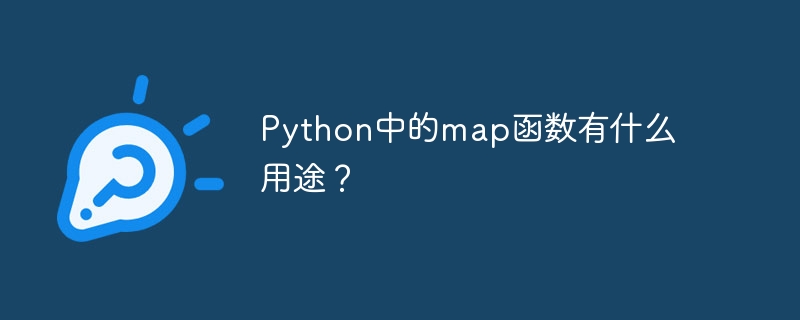
在本文中,我們將學習Python中map函數的使用。
Python的map()函數將一個函數應用於作為輸入提供的迭代器中的每個項目。列表、元組、集合、字典或字串都可以用作迭代器,並且它們都傳回可迭代的map物件。 map()是Python的內建函數。
map(function, iterator1,iterator2 ...iteratorN)
function - 有必要提供一個帶有函數的映射,該函數將應用於迭代器的所有可用項目。
iterator - 強制可迭代物件。它可以是列表、元組等。 map() 函數接受多個迭代器物件作為參數。
map() 方法會將指定的函數套用至迭代器中的每個項目,並產生一個元組、列表或另一個可迭代的映射物件。
函數和可迭代物件是map()函數的兩個輸入。傳遞給map()的函數是一個普通函數,它將遍歷指定可迭代物件中的每個值。
以下程式使用 Python 中的 map() 函數將 5 加到列表中的每個元素 -
# creating a function that accepts the number as an argument
def exampleMapFunction(num):
# adding 5 to each number in a list and returning it
return num+5
# input list
inputList = [3, 5, 1, 6, 10]
# Passing above defined exampleMapFunction function
# and given list to the map() function
# Here it adds 5 to every element of the given list
modifiedList = map(exampleMapFunction, inputList)
# printing the modifies list(map object)
print(modifiedList)
# converting the map object to the list and printing it
print("Adding 5 to each element in a list using map():\n", list(modifiedList))
<map object at 0x7fb106076d10> Adding 5 to each element in a list using map(): [8, 10, 6, 11, 15]
Python使用字典來實作更常見的關聯數組。字典是一組鍵值對。它使用花括號 {} 來定義。
字典是動態的、不斷變化的。可以根據需要更改和刪除它們。字典項可以使用鍵訪問,但列表元素是透過索引根據其在列表中的位置來檢索的,這就是字典與列表的不同之處。
由於字典是迭代器,因此您可以在 map() 函數內部使用它。
以下程式使用 Python 中的 map() 函數將 5 加入字典中的每個元素 -
# creating a function that accepts the number as an argument
def exampleMapFunction(num):
# adding 5 to each number in a dictionary and returning it
return num + 5
# input Dictionary
inputDictionary = {2, 3, 4, 5, 6, 7, 8, 9}
# passing above defined exampleMapFunction function
# and input dictionary to the map() function
# Here it adds 5 to every element of the given dictionary
modifiedDict = map(exampleMapFunction, inputDictionary)
# printing the modified dictionary(map object)
print(modifiedDict)
# converting the map object to the list and printing it
print("Adding 5 to each element in a dictionary using map():\n", list(modifiedDict))
<map object at 0x7fb1060838d0> Adding 5 to each element in a dictionary using map(): [7, 8, 9, 10, 11, 12, 13, 14]
在Python中,元組是一個由逗號分隔的元素並用圓括號括起來的物件。
以下程式碼使用lower()和map()函數將元組中的所有項轉換為小寫:
# creating a function that accepts the number as an argument
def exampleMapFunction(i):
# converting each item in tuple into lower case
return i.lower()
# input tuple
inputTuple = ('HELLO', 'TUTORIALSPOINT', 'pyTHON', 'CODES')
# passing above defined exampleMapFunction function
# and input tuple to the map() function
# Here it converts every element of the tuple to lower case
modifiedTuple = map(exampleMapFunction, inputTuple)
# printing the modified tuple(map object)
print(modifiedTuple)
print('Converting each item in a tuple to lowercase:')
# converting the map object to the list and printing it
print(list(modifiedTuple))
<map object at 0x7fb10f773590> Converting each item in a tuple to lowercase: ['hello', 'tutorialspoint', 'python', 'codes']
使用map()與函數工具如filter()和reduce()一起,我們可以在可迭代物件上執行更複雜的變更。
在某些情況下,我們必須處理可迭代的輸入,並透過從輸入中刪除/過濾不必要的項目來傳回另一個可迭代物件。在這種情況下,Python的filter()是一個明智的選擇。
filter()函數傳回滿足函數傳回true的可迭代輸入項目。
如果沒有傳遞函數,則filter()會使用身分函數。這表示filter()會檢查可迭代物件中的每個項目的真值,並刪除所有假值。
以下函數結合使用filter()和map()函數過濾列表中的所有正數並傳回它們的平方根 -
# importing math module import math # creating a function that returns whether the number # passed is a positive number or not def isPositive(n): return n >= 0 # creating a function that filters all the positive numbers # from the list and returns the square root of them. def filterSqrtofPositive(nums): # filtering all the positive numbers from the list using filter() # and returning the square root of them using the math.sqrt and map() filteredItems = map(math.sqrt, filter(isPositive, nums)) # returning the list of filetred elements return list(filteredItems) # input list inputList= [16, -10, 625, 25, -50, -25] # calling the function by passing the input list print(filterSqrtofPositive(inputList))
[4.0, 25.0, 5.0]
Python 的 map() 函數可讓您對可迭代物件執行操作。 Map() 通常用於轉換和處理可迭代對象,而不需要循環。
在本文中,我們以幾種資料型別為例,學習如何在 Python 中使用 map() 方法。
以上是Python中的map函數有什麼用途?的詳細內容。更多資訊請關注PHP中文網其他相關文章!




